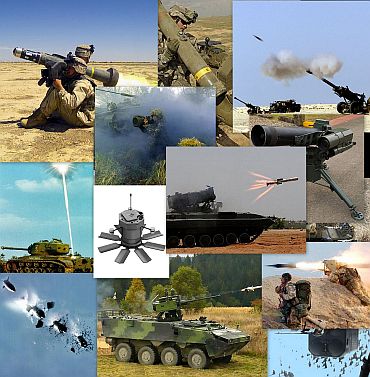
Infantry is crucial for the frontline defence of nations around the world. As technology evolved, these assault vehicles have grown faster and deadlier. The armour-plating on the combat vehicles too has seen numerous upgrades over the decades, As lethal they are for their enemies, they too have their nemesis.
Armour-piercing missiles have been making life miserable for most infantrymen, especially tankmen. Most modern Anti-Tank Guided Missiles have shaped charge high explosive warheads, designed specifically for penetrating armour.
Top-attack weapons such as the India's Nag, American Javelin and the Swedish Bill are designed to focus the explosion down through an armoured fighting vehicle's thinner turret-roof or upper-hull armour.
Let's take a look at some of the deadliest anti-tank missiles in world today. Please click on NEXT to go further...
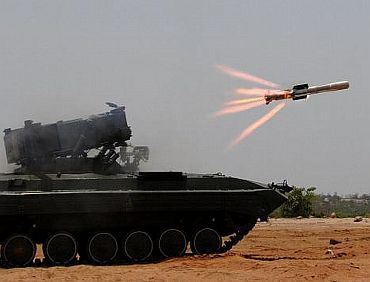
The Nag is a third-generation (Gen-3), 'fire-and-forget' missile; once it is fired, its seeker automatically guides the missile to even a fast-moving tank. In earlier-generation missiles an operator had to guide it all the way, often exposing himself to enemy fire.
Nag missile operators search for enemy tanks through thermal imaging telescopes, which see as well by night as they do by day.
Picking up a tank, the operator locks the Nag's seeker onto the target. A digital snapshot of the target is automatically taken, which serves as a reference image.
As the Nag streaks towards the target, at 230 metres per second, the seeker takes repeated snapshots of the target; each one is compared with the reference image, and deviations are translated through on-board algorithms into corrections to the Nag's control fins, which steer the missile precisely at the target.
Maximum effective range: 4 km (Guidance mode: IIR (Imaging infra-red)), 7 km for air-launched variant
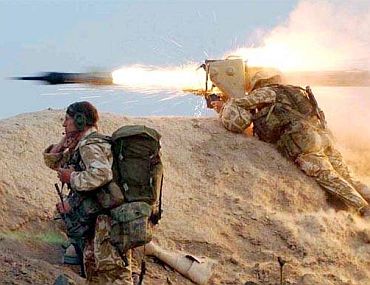
The BILL 2 missile was designed upon the original BILL 1 Anti-tank guided weapon that has been in the service of the Swedish Army since 1988.
The BILL 2 comes with one 10.5 kg missile, a launching tube, tripod with x7 magnification day sight, and one thermal imaging sight. The missile uses OTA or Overfly Top Attack to attack its target.
The missile flies towards the target on a standard horizontal trajectory, but rather than directly hitting the target head on, it overflies it, detonating its warhead on top of an armoured vehicle, where the armour is usually lighter.
It also utilises additional guidance accuracy via the installed rate gyro, which monitors the tracking movement of the launcher. It is designed primarily to attack armoured or unarmoured vehicles, but can also be used to attack helicopters or soft ground targets, such as light buildings.
The missile system is effective against both static and moving targets with an effective range of 150m to 2,200m. Flight time at maximum range is 13 seconds

The M93 Hornet is an anti-tank off-route munition made of lightweight material (35 pounds) that one person can carry and employ.
The Hornet is a non-recoverable munition that is capable of acquiring targets by using sound and motion detection methods.
When the mine detects a suitable target in range, the mine turns to face the target and elevates the submunition launcher to the correct angle. The submunition is then fired in the direction of the target using a gas generator.
Once the Hornet is armed and the self-test is performed, the munition will remain active until its self-destruct (SD) time expires or until it is encountered. The SD time (4 hours, 48 hours, 5 days, 15 days, or 30 days) is determined by the user. The munition will self-detonate after the SD time has expired.
Hornet munitions have an employed life of 60 days in the pre-armed mode (remote arming) and 30 days in the armed mode. If the temperature exceeds 100 degree Fahrenheit, the employed life drops to 15 days in the pre-armed mode and 30 days in the armed mode. Its standoff distance is up to 100 meters from the deployment site

The MBT LAW is a man-portable, fire and forget, disposable weapon consisting of an anti-tank missile sealed within a launch tube.
The MBT LAW has been designed to counter main battle tanks at short ranges as well as buildings, fortifications and non-armoured vehicles. The weapon features a single shaped charge detonated by magnetic and optical sensors striking downward at 90-degree.
It only weighs less than 12 kg and is absolutely free of maintenance. The weapon operator must track the target during 2-3 seconds before the launch.
During that time the guidance control system of the MBT LAW calculates the foreseeable position of the target. The weapon can be launched at 45-degree upward/downward.
Once launched, the projectile follows top-attack or direct attack profile according to pre-launch settings.
Max Range: 600 m, Minimum Range 20 m, Top Speed 200 mps
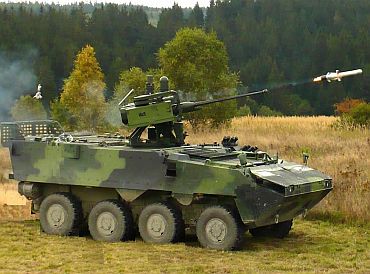
Rafael, based in Haifa, Israel, manufactures the Spike family of anti-armour weapons. The weapons are lightweight fire-and-forget anti-tank missiles and use electro-optical and fibre-optic technologies.
The weapon consists of the missile in its canister and the firing post comprising a command launch unit, thermal imager and firing post. The operator can maintain tracking and update aim points while the missile is in flight, and even change targets in mid-flight. SPIKE is quick, too.
Utilising the fiber-optic communications link, the Spike missile can also get target and guidance updates during the flight. The Spike Family consists of missiles suited for several platforms, multiple ranges and a variety of targets.
In fire-and-forget mode, the soldier activates the missile, locking the tracker on the target and pushes the fire button to launch. The missile automatically propels itself towards the target without any additional interaction and this fire-and-forget capability allows the soldier the option of relocating to a new firing position or to reload immediately for the next engagement.
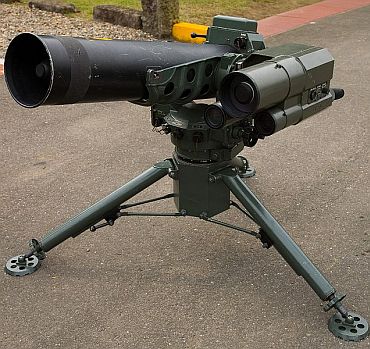
The Type 01 LMAT is a Japanese man-portable fire-and-forget anti-tank missile.
The missile guidance system, infrared detection is nested and launchers that carry the equivalent weight is 17.5 kg and also for applying and firing a single missile is enough soldiers.
Similar to other modern anti-tank missiles, it is a deadly weapon feared by armoured vehicles crewmen.
At the speed of 4 Kilometers per minutes, it delivers an accurate point fire out over several kilomoters with its Infrared homing guidance system.
Since 2001, the Type 01 LMAT is into service with the Japan Self Defence Forces.
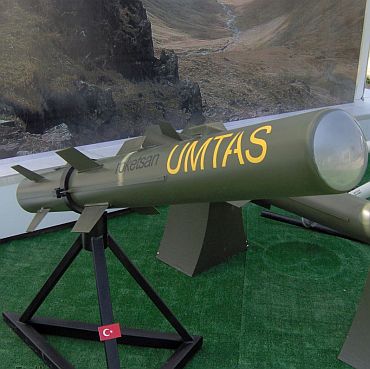
OMTAS has a maximum range of 4km and is fitted with a nose-mounted imaging infrared seeker and a tandem HEAT warhead.
It has fire-and-forget and fire-and-update modes and can be launched from a confined space.
The OMTAS has the following capabilities:
1) Lock-on before and after launch
2) Can be used in day or night and in adverse weather conditions
3) Tandem warhead, effective against reactive armours
4) Insensitive munition characteristics against liquid fuel fire and bullet hits Communication of seeker image to the user and command by user using Data Link.
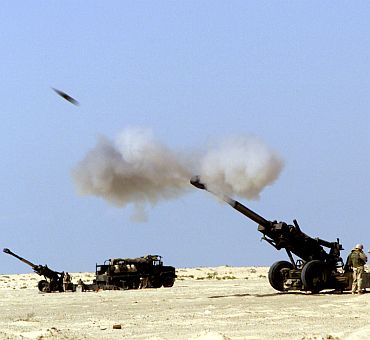
SADARM (Sense and Destroy Armor) is a 'smart' artillery submunition designed for precision engagement of self-propelled howitzers as well as other lightly armoured vehicles.
SADARM is designed to attack and kill lightly armoured vehicles. It is dispensed from a 155 millimeter (mm) howitzer round. Each howitzer round delivers two submunitions. Once dispensed, the submunition deploys a parachute-like deceleration device.
At a predetermined distance from the ground, the submunition ejects the deceleration device and deploys another device to stabilize and rotate the submunition. As the submunition falls and rotates, it searches the ground with a millimeter wave sensor and an infrared sensor array.
Using the two sensors and detection logic, the submunition is designed to detect countermeasured targets in a variety of climates. If the sensor detects a target, the submunition fires an explosively formed penetrator (EFP) at the target. If no target is detected the submunition is designed to self-destruct. It is reported to have a range of 15 kilometers
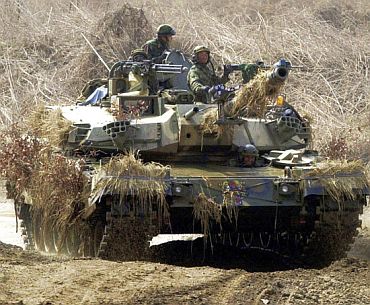
The KSTAM stands for Korean Smart Top-Attack Munition, and is a smart munition intended to be launched from the gun of a main battle tank, namely the K2 Black Panther.
The KSTAM is a smart fire-and-forget projectile that have their own guidance system using stabilising fins during flight.
These rounds can be fired from behind cover and have a maximum range of 8 kilometers (4.97 miles).
The munition, designed specifically for use with the Black Panther main battle tank, has its own guidance and obstacle-avoidance systems, small millimeter band RADAR, IR, radiometer sensors and Explosively Formed Penetrator.
After being fired, the munition will follow its firing trajectory, aided by four fins to stabilise its flight, and travel over to its designated target area, whereupon a parachute will deploy to slow its fall, giving the onboard RADAR system and sensors enough time to seek and acquire stationary or moving targets and fire away its EFP at the top of the target.

The Javelin is the first man-portable fire-and-forget anti-armour missile in service with US Army and Marine Corps ground forces, and as such has replaced the older FGM-77 Dragon.
The Javelin's range of approximately 2,500 meters is more than twice that of its predecessor, the Dragon. A complete Javelin system consists of the CLU (Command Launch Unit) and the FGM-148A missile in its disposable launch tube.
Before firing, the reusable CLU is mated with the launcher, and the gunner has to find a target through the CLU's sights. When the trigger is pulled, the FGM-148A is ejected from the tube by a low-g soft launch motor.
This keeps the recoil forces down, and makes the system usable e.g. from within buildings or vehicles. When the missile has cleared the tube, the main motor ignites, and the six small wings and four tail fins flip out.
The FGM-148A flies at altitudes above ground of up to 50m (160 ft) for the direct attack or 150 m (490 ft) for the top attack mode. The Javelin's IIR (Imaging Infrared) seeker with its staring focal plane array will guide the missile to the target, and the tandem shaped charge warhead detonates on impact.
The warhead section consists of a precursor warhead to defeat ERA (Explosive Reactive Armour) and a main warhead to penetrate up to 800 mm of conventional armour.

PARS 3 LR (third generation missile/long-range) is the main armament for the Tiger helicopter ordered by the German Army.
PARS 3 LR is a high-precision fire-and-forget weapon system for engaging mobile and stationary targets equipped with the latest generation of armour protection, field fortresses, bunkers and other high-value targets.
The 'fire-and-forget' system allows the helicopter to quit its position immediately after firing a missile, thereby exposing itself only as briefly as necessary to the threat of retaliation.
The infrared seeker head locks on to the target before firing (lock-on before launch) after the optical system integrated into the Tiger's mast sight has detected and identified it.
The missile navigates to the target autonomously, without requiring further influencing or control from the gunner.
The operating range is given as 500 m to 5,000 m, but the range is extendible to 7,000 m. Salvo firing provides a firing rate of up to four missiles in eight seconds
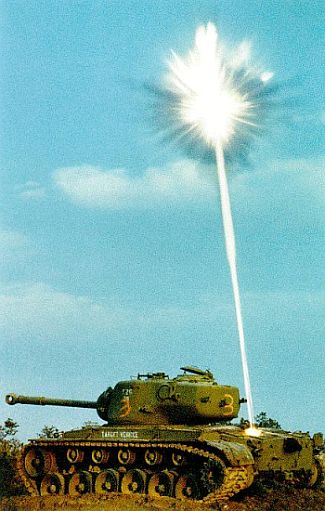
The CBU-97 is a 1,000-pound class weapon containing sensor-fused submunitions for attacking armour.
The Sensor Fuzed Weapon is an unpowered, top attack, wide area, cluster munition, designed to achieve multiple kills per aircraft pass against enemy armour and support vehicles.
After release, the Tactical Munitions Dispenser opens and releases the ten submunitions, which are parachute stabilised.
Each of the 10 BLU-108/B submunitions contains four armor-penetrating projectiles with infrared sensors to detect armoured targets.
At a preset altitude sensed by a radar altimeter, a rocket motor fires to spin the submunition and initiate an ascent. The submunition then releases its four projectiles, which are lofted over the target area.
The projectile's sensor detects a vehicle's infrared signature, and an explosively formed penetrator fires at the heat source. If no target is detected after a period of time, the projectiles automatically after a preset time interval, causing damage to material and personnel.
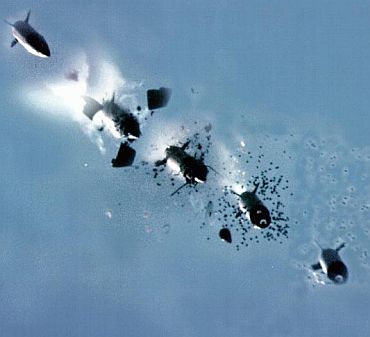
The BLU-108 is an advanced submunition designed to effectively engage and destroy armoured vehicles.
Each BLU-108 contains four armor-penetrating projectiles equipped with infrared sensors to detect armored targets. These four armour penetrating projectiles are sensitive to the target's heat.
Once the BLU-108 warhead has been dropped from its dispenser, a parachute takes care of stabilising it.
At a pre-programmed altitude determined by a radar altimeter the BLU-108's ignites initiating the ascent. The submunition the releases its four projectiles lofted over the target area.
The four shaped skeet infrared sensing armor penetrating projectiles use top-attack profile to hit the target where the armour is weaker increasing the odds for a successful kill. In 2005, the BLU-108 warhead was integrated into the CBU-97/CBU-105 Sensor Fused Weapon

The BGM-71 TOW missile is the main heavy anti-tank guided missile of the US Army and US Marine Corps, and is used in vehicle and helicopter installations.
The TOW is a crew portable, vehicle-mounted, heavy anitarmor weapon system consisting of a launcher and one of five versions of the TOW missile.
It is designed to defeat armoured vehicles and other targets such as field fortifications from ranges up to 3,750 meters. After firing the missile, the gunner must keep the cross hairs of the sight centered on the target to ensure a hit.
The system will operate in all weather conditions in which the gunner can see a target throughout the missile flight by using either a day or night sight. The TOW is controlled in flight by its four gas-operated movable tail fins. The high-explosive shaped-charge warhead of the BGM-71A detonates on impact, and can penetrate armour with a thickness of about 600 mm.
Minimum range for the TOW is about 65 m, and maximum range is limited by the length of the guidance wire, which is 3000 m (3280 yds) for the BGM-71A.